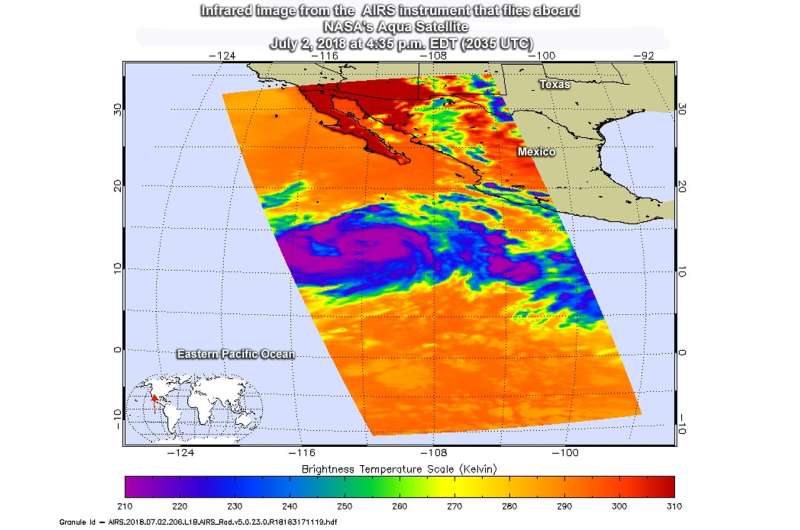NASA's Aqua satellite passed over Hurricane Fabio on July 2 at 4:35 p.m. EDT (2035 UTC) and saw coldest cloud top temperatures (purple) around the center of circulation and in thick feeder bands wrapping into storm's center. Credit: NASA JPL/Heidar Thrastarson
When NASA's Aqua satellite passed over Hurricane Fabio in the Eastern Pacific Ocean it had strengthened into a hurricane hours earlier. Infrared imagery showed that Fabio appeared more organized.
NASA's Aqua satellite passed over Hurricane Fabio on July 2 at 4:35 p.m. EDT (2035 UTC) .The Atmospheric Infrared Sounder or AIRS instrument analyzed the storm in infrared light which provides temperature information. Temperature is important when trying to understand how strong storms can be. The higher the cloud tops, the colder and the stronger they are. Cloud top temperatures were as cold as minus 63 degrees Fahrenheit (minus 53 degrees Celsius). Storms with cloud top temperatures that cold have the capability to produce heavy rainfall.
At that time, although a banding eye-like feature appeared in visible imagery, it wasn't evident in infrared data, including in the AIRS image.
The National Hurricane Center (NHC) noted on 5 a.m. EDT (0900 UTC) on July 3 "The eye has been observed intermittently on conventional imagery during the past few hours, and the convection surrounding the eye has not changed much."
The center of Hurricane Fabio was located near latitude 15.1 degrees north and longitude 114.5 degrees west. That's about 615 miles (990 km) south-southwest of the southern tip of Baja California, Mexico.
Fabio was moving toward the west-northwest near 15 mph (24 kph), and this general motion is expected to continue during the next several days. Maximum sustained winds remain near 90 mph (150 kph) with higher gusts. Hurricane-force winds extend outward up to 35 miles (55 km) from the center and tropical-storm-force winds extend outward up to 160 miles (260 km).
Strengthening is expected and Fabio is forecast to be a major hurricane later today, July 3 or early Wednesday, July 4. However, later on July 4, a large portion of the circulation is expected to be affected by cooler waters and gradual weakening should begin.
Provided by NASA's Goddard Space Flight Center
























